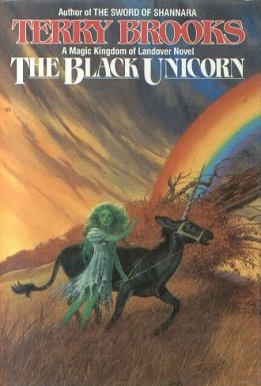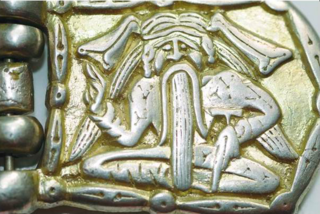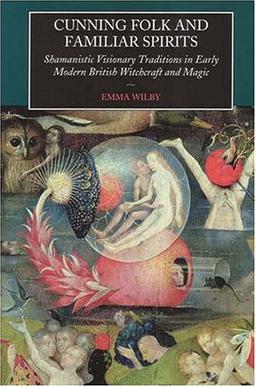
A fairy is a type of mythical being or legendary creature, generally described as anthropomorphic, found in the folklore of multiple European cultures, a form of spirit, often with metaphysical, supernatural, or preternatural qualities.

Necromancy is the practice of magic involving communication with the dead by summoning their spirits as apparitions or visions for the purpose of divination; imparting the means to foretell future events and discover hidden knowledge. Sometimes categorized under death magic, the term is occasionally also used in a more general sense to refer to black magic or witchcraft as a whole. In fictional settings such as Dungeons & Dragons, or fantasy video games, it is associated with the reanimation of corpses often meant to be used as weapons.

In mythology, folklore and speculative fiction, shapeshifting is the ability to physically transform oneself through unnatural means. The idea of shapeshifting is in the oldest forms of totemism and shamanism, as well as the oldest existent literature and epic poems such as the Epic of Gilgamesh and the Iliad. The concept remains a common literary device in modern fantasy, children's literature and popular culture.

In European folklore of the medieval and early modern periods, familiars were believed to be supernatural entities or spiritual guardians that would protect or assist witches and cunning folk in their practice of magic. According to records of the time, those alleging to have had contact with familiar spirits reported that they could manifest as numerous forms, usually as an animal, but sometimes as a human or humanoid figure, and were described as "clearly defined, three-dimensional... forms, vivid with colour and animated with movement and sound", as opposed to descriptions of ghosts with their "smoky, undefined form[s]".
In Germanic paganism, a seeress is a woman said to have the ability to foretell future events and perform sorcery. They are also referred to with many other names meaning "prophetess", "staff bearer", "wise woman" and "sorceress", and they are frequently called witches or priestesses both in early sources and in modern scholarship. In Norse mythology the seeress is usually referred to as völva or vala.

In fairy tales, a fairy godmother is a fairy with magical powers who acts as a mentor or parent to someone, in the role that an actual godparent was expected to play in many societies. In Perrault's Cinderella, he concludes the tale with the moral that no personal advantages will suffice without proper connections.

A werecat is an analog to "werewolf" for a feline therianthropic creature.
Susan Price is an English author of children's and young adult novels. She has won both the Carnegie Medal and the Guardian Prize for British children's books.
Ruth Manning-Sanders was an English poet and author born in Wales, known for a series of children's books for which she collected and related fairy tales worldwide. She published over 90 books in her lifetime
Prunella is an Italian fairy tale, originally known as Prezzemolina. Andrew Lang included it in The Grey Fairy Book. It is Aarne-Thompson type 310, the Maiden in the Tower.

The Black Unicorn is the second novel in the Magic Kingdom of Landover series by Terry Brooks, and the follow-up to Magic Kingdom for Sale—Sold!. Published in 1987, the book revolves around the evil wizard Meeks, attempting to wrest control of the kingdom from Ben Holiday, the High Lord and the appearance of a mythical black unicorn in the kingdom.

Hungarian mythology includes the myths, legends, folk tales, fairy tales and gods of the Hungarians, also known as the Magyarok.
This is a list of books by Mercedes Lackey, arranged by collection.

The Changeover: a Supernatural Romance is a low fantasy novel for young adults by Margaret Mahy, published in 1984 by J. M. Dent in the U.K. It is set in Christchurch in the author's native New Zealand.

Collected Stories for Children is a collection of 17 fantasy stories or original fairy tales by Walter de la Mare, first published by Faber in 1947 with illustrations by Irene Hawkins. De la Mare won the annual Carnegie Medal recognising the year's best children's book by a British subject. It was the first collection to win the award and the first time that previously published material had been considered.

Cunning Folk and Familiar Spirits: Shamanistic Visionary Traditions in Early Modern British Witchcraft and Magic is a study of the beliefs regarding witchcraft and magic in Early Modern Britain written by the British historian Emma Wilby. First published by Sussex Academic Press in 2003, the book presented Wilby's theory that the beliefs regarding familiar spirits found among magical practitioners – both benevolent cunning folk and malevolent witches – reflected evidence for a general folk belief in these beings, which stemmed from a pre-Christian visionary tradition.

Shararat – Thoda Jaadu, Thodi Nazaakat is an Indian fantasy sitcom which aired on Star Plus channel from 2003 to 2006. The show is loosely based on the American teen sitcom Sabrina the Teenage Witch.
The Witch is a 1906 French short silent film by Georges Méliès. The film is named for a witch, Carabosse, who tells a poor troubadour that he is destined to rescue a damsel in distress, but demands a high price for a magic charm to help the troubadour in his quest. When the troubadour cheats the witch to obtain the magic charm, she sets out in pursuit of him, and puts various obstacles in his way before finally being vanquished by forces of good.
Lower mythology is a sphere of mythological representations relating to characters who have no divine status, demons and spirits, as opposed to higher gods and the official cult. This opposition is particularly pronounced in world religions.












